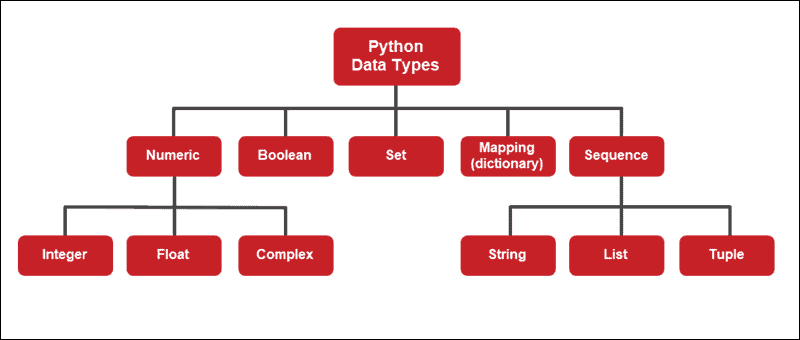What is List Data Type in Python?

In Python, sequence is the ordered collection of similar or different data types. Sequences allows to store multiple values in an organized and efficient fashion. There are several sequence types in Python –
- String
- List
- Tuple
1) String
In Python, Strings are arrays of bytes representing Unicode characters. A string is a collection of one or more characters put in a single quote, double-quote or triple quote. In python there is no character data type, a character is a string of length one. It is represented by str class.
Code:
# Python Program for
# Creation of String
# Creating a String
# with single Quotes
String1 = 'Welcome to the My World'
print("String with the use of Single Quotes: ")
print(String1)
# Creation of String
# Creating a String
# with single Quotes
String1 = 'Welcome to the My World'
print("String with the use of Single Quotes: ")
print(String1)
Output:
String with the use of Single Quotes:
Welcome to the My World
Welcome to the My World
2) List
Lists are just like the arrays, declared in other languages which is a ordered collection of data. It is very flexible as the items in a list do not need to be of the same type.
Code:
# Python program to demonstrate
# Creation of List
# Creating a List
List = []
print("Initial blank List: ")
print(List)
# Creating a List with
# the use of a String
List = ['GeeksForGeeks']
print("\nList with the use of String: ")
print(List)
# Creating a List with
# the use of multiple values
List = ["Geeks", "For", "Geeks"]
print("\nList containing multiple values: ")
print(List[0])
print(List[2])
# Creating a Multi-Dimensional List
# (By Nesting a list inside a List)
List = [['Geeks', 'For'], ['Geeks']]
print("\nMulti-Dimensional List: ")
print(List)
# Creation of List
# Creating a List
List = []
print("Initial blank List: ")
print(List)
# Creating a List with
# the use of a String
List = ['GeeksForGeeks']
print("\nList with the use of String: ")
print(List)
# Creating a List with
# the use of multiple values
List = ["Geeks", "For", "Geeks"]
print("\nList containing multiple values: ")
print(List[0])
print(List[2])
# Creating a Multi-Dimensional List
# (By Nesting a list inside a List)
List = [['Geeks', 'For'], ['Geeks']]
print("\nMulti-Dimensional List: ")
print(List)
Output:
Initial blank List:
[]
List with the use of String:
['GeeksForGeeks']
List containing multiple values:
Geeks
Geeks
Multi-Dimensional List:
[['Geeks', 'For'], ['Geeks']]
[]
List with the use of String:
['GeeksForGeeks']
List containing multiple values:
Geeks
Geeks
Multi-Dimensional List:
[['Geeks', 'For'], ['Geeks']]
3) Tuple
Just like list, tuple is also an ordered collection of Python objects. The only difference between tuple and list is that tuples are immutable i.e. tuples cannot be modified after it is created. It is represented by tuple class.
Code:
# Python program to demonstrate
# creation of Set
# Creating an empty tuple
Tuple1 = ()
print("Initial empty Tuple: ")
print (Tuple1)
# Creating a Tuple with
# the use of Strings
Tuple1 = ('Geeks', 'For')
print("\nTuple with the use of String: ")
print(Tuple1)
# Creating a Tuple with
# the use of list
list1 = [1, 2, 4, 5, 6]
print("\nTuple using List: ")
print(tuple(list1))
# Creating a Tuple with the
# use of built-in function
Tuple1 = tuple('Geeks')
print("\nTuple with the use of function: ")
print(Tuple1)
# Creating a Tuple
# with nested tuples
Tuple1 = (0, 1, 2, 3)
Tuple2 = ('python', 'geek')
Tuple3 = (Tuple1, Tuple2)
print("\nTuple with nested tuples: ")
print(Tuple3)
# creation of Set
# Creating an empty tuple
Tuple1 = ()
print("Initial empty Tuple: ")
print (Tuple1)
# Creating a Tuple with
# the use of Strings
Tuple1 = ('Geeks', 'For')
print("\nTuple with the use of String: ")
print(Tuple1)
# Creating a Tuple with
# the use of list
list1 = [1, 2, 4, 5, 6]
print("\nTuple using List: ")
print(tuple(list1))
# Creating a Tuple with the
# use of built-in function
Tuple1 = tuple('Geeks')
print("\nTuple with the use of function: ")
print(Tuple1)
# Creating a Tuple
# with nested tuples
Tuple1 = (0, 1, 2, 3)
Tuple2 = ('python', 'geek')
Tuple3 = (Tuple1, Tuple2)
print("\nTuple with nested tuples: ")
print(Tuple3)
Output:
Initial empty Tuple:
()
Tuple with the use of String:
('Geeks', 'For')
Tuple using List:
(1, 2, 4, 5, 6)
Tuple with the use of function:
('G', 'e', 'e', 'k', 's')
Tuple with nested tuples:
((0, 1, 2, 3), ('python', 'geek'))
()
Tuple with the use of String:
('Geeks', 'For')
Tuple using List:
(1, 2, 4, 5, 6)
Tuple with the use of function:
('G', 'e', 'e', 'k', 's')
Tuple with nested tuples:
((0, 1, 2, 3), ('python', 'geek'))
